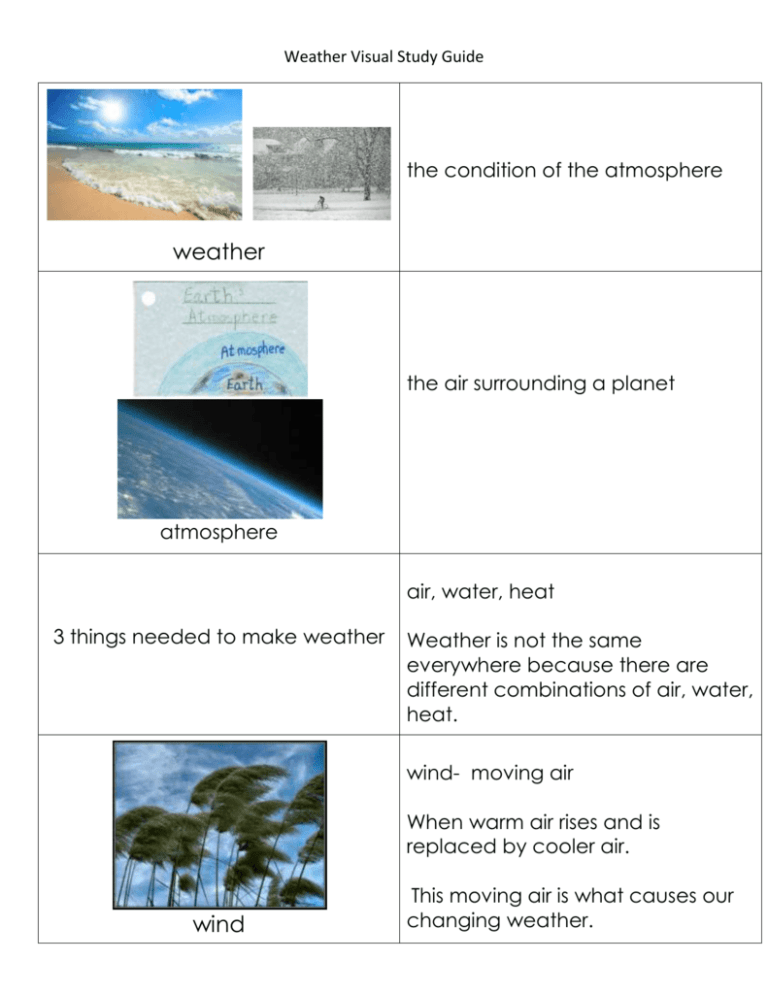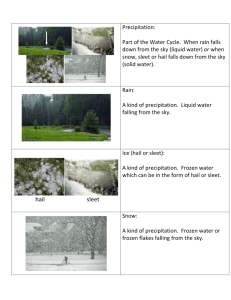part of the water cycle
advertisement

Weather Visual Study Guide the condition of the atmosphere weather the air surrounding a planet atmosphere air, water, heat 3 things needed to make weather Weather is not the same everywhere because there are different combinations of air, water, heat. wind- moving air When warm air rises and is replaced by cooler air. wind This moving air is what causes our changing weather. The journey water takes as it circulates from the land to the sky and back again. 1. evaporation 2. condensation 3. precipitation 4. collection water cycle part of the water cycleto change from a liquid → gas When water (liquid) heats up, it rises up into the sky and changes into water vapor. evaporation part of the water cycleto change from a gas → liquid condensation When the water vapor cools and condenses high in the atmosphere, the millions of tiny water droplets form clouds. made up of millions of tiny liquid water droplets clouds 4 common types of clouds: 1. cirrus 2. cumulus 3. cumulonimbus 4. stratus Thin, wispy ice clouds high in the sky. Often seen in clear skies and mean good weather, but usually appear the day before rain or snow. cirrus clouds Large, thick, and fluffy lower clouds that often “grow” during sunny days. Usually mean good weather. cumulus clouds Giant thunderhead clouds that tower to high heights. Thunderstorms with heavy rain, hail, winds, and lightening are on the way. cumulonimbus clouds Blanket like, flat layer of low level clouds. Fog, light rain, drizzle, or flurries likely. stratus clouds part of the water cycleclouds lose their water when water in either liquid or solid state falls down from the sky. precipitation a form of precipitationliquid water that falls from the sky back to the earth rain a form of precipitationsolid water that falls from the sky back to the earth hail sleet ice a form of precipitationsolid water that falls from the sky back to the earth snow part of the water cycle- collection or run off when precipitation is either absorbed into the ground or runs off into rivers that flow into ponds, lakes, or oceans. Water that was absorbed into the ground is taken up by plants. . Instrument that measures weatherused to measure how much rain fell measured in inches or millimeters rain gauge Instrument that measures weatherused to measure what direction the wind is blowing: north, south, east, or west weather vane Instrument that measures weatherused to measure temperature: how hot or cold the air is measured in degrees Celsius or degrees Fahrenheit thermometer extreme type of stormy weather Storm with heavy rains and wind. They form over warm oceans and move to the land. hurricane generally June to November (summer and fall seasons) extreme type of stormy weather Storm with large amounts of snow and heavy winds. blizzard winter season extreme type of stormy weather Violent wind storm with strong winds that spin. generally spring, sometimes fall tornado extreme type of stormy weather Storm with heavy rain, thunder and lightning. thunderstorm generally summer, sometimes spring and fall cause: lots of rain falls effect of weather: there is so much water that it overflows onto land. flooding cause: very little to no rain falls effect of weather: very dry land, plants and animals often die due to lack of water to survive drought weather over a long period of time climate Our climate in Ashburn (northern Virginia has hot and humid summers, mild winters, and 4 seasons. Part of the year that has the same kind of weather patterns. We have 4 seasons: Winter, spring, summer, autumn (or fall) season one of the four seasonsWinter weather can be cold and snowy. Animals grow thick fur and some hibernate. Many plants die or lay dormant. winter one of the four seasonsSpring weather can be windy and rainy. Many animals give birth to their young in spring. Plants begin to grow. spring one of the four seasonsSummer weather can be hot and dry. Some animals estivate (sleep in the summer because so hot). Plants grow and give fruit. summer one of the four seasonsFall weather can be cool and dry. Animals prepare for the winter. Plants mature and are harvested. Seeds fall to the ground. autumn or fall




